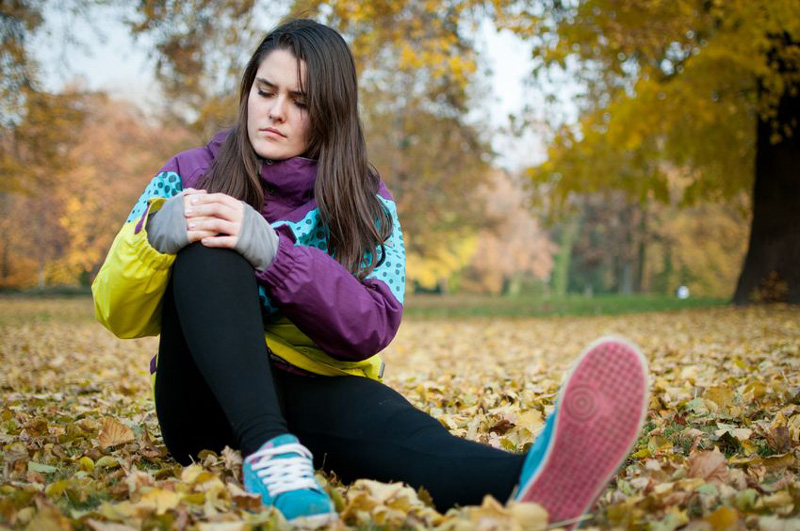NAFC NewsBlast - Novemeber 2017 | Ed 2
Strategies for Fall Prevention and Avoiding Injury
Written by: Tammy LeBoss, The FitPro Foodie
Sources: Center for Disease Control, SmartCells™, NAFC Mat Pilates™
 Copyright: https://www.123rf.com/profile_martinan'>martinan / 123RF Stock Photo
Copyright: https://www.123rf.com/profile_martinan'>martinan / 123RF Stock Photo
Best Ways to Avoid Injury When Falling
“And all at once summer collapsed into fall.” –Oscar Wilde.
As the seasons change, the increased chances of rain or snow and fallen leaves make falling more likely to take place. Falls can happen at any time, not only for our elderly loved ones but also for regular exercisers who expose themselves to potential outdoor hazards. While slips and falls may be a seasonal concern for younger generations, our elderly loved ones face the potential dangers of slips and falls on a daily basis.
According to Center for Disease Control, 30-35% of people over age 65 fall each year, one in five of those falls involve a serious injury, and 65% of those falls result in an emergency room visit. A bone fracture or any other fall-related injury can be extremely dangerous and is often considered the beginning of an elderly person’s demise. In fact, the CDC also found that “approximately 20% of older adults hospitalized for a hip fracture die within a year and about 50% will suffer a major decline in independence.”
Through awareness and preventative measures, these numbers can be greatly reduced. Regardless of the season or age group, everyone needs to understand the causes of falling and take preventative measures.
The Best Way for Preventing Falls
What is the best way to take a stand against falling and avoid injury? You guessed it, through exercising! Remember the old adage: If you don’t use it, you lose it. Strategies for reducing the risk of a fall include:
- Learning different ways to strengthen the core muscles
- Incorporating ways of challenging our balance
- Strengthen the gluteal muscles (do more squats)
- Taking walks to strengthen the muscles necessary to keep us upright.
Walking is a great form of ‘moving meditation’ that can improve body awareness and proprioception.
Fall in love with walking using these pro tips:
- Make sure walkways are well-lit and cleared of clutter
- Choose your route wisely- avoid sidewalks that have cracks, holes, or any other irregularities
- Train your eyes to ‘see all’ scanning continuously for potential hazards
- Avoid walking in stormy weather, especially during rain, snow or fog
- Walk in areas of good visibility and traction
- Look for cleared and well-maintained areas
- Walk with a companion who can warn you about potential hazards (2 sets of eyes are better than one)
- Be prepared with the right gear and wear shoes with good traction soles
- Learn to walk in your neutral spine (apply NAFC ANSER™)
- Pay attention to your heel strike, pronation, and supination of the feet (learn more through NAFC Mat and Reformer Pilates).
Another way to take a stand to prevent falls involves learning how to fall safely. There are three basic types of falls: front falling, side falling and backwards falling. Each type requires its own techniques to reduce injuries and land in a safer manner. According to experts at Five Star Senior Living and Texas Women’s University, to reduce the likelihood of an injury, here are some tips to apply in case of a fall:
For Forward Falls
- Hit ground with entire palm and forearm- This reduces the likelihood of a wrist fracture.
- Turn your head to the side- Reduces risk of hitting your nose or mouth on the ground.
- Try to land on your palms and forearms in a pushup position without letting the rest of your body touch the ground.
- Breathe out
- Avoid Locking your joints
For Side Falls
- Hit ground with entire palm and forearm on the side you fall on- If left side use left arm etc.
- Grab your hip with opposite arm- If falling to left use right arm to grab hip
- Tuck your chin to your chest to avoid your head hitting the ground.
- Squat
- Try to roll to your back
- Avoid landing directly on your hip
For Backward Falls
- Bend at knees and squat
- Tuck chin to avoid hitting head
- Hit the ground with forearms first
- Round Back
There are many precautions we can take in order to reduce the likelihood of a fall and any fall-related injuries. Using a combination of exercises, falling techniques, basic indoor/outdoor changes and applying an understanding of the causes—are great places to start a graceful falling into fall and winter. Share this article with a loved one to prevent them from falling ☺
Written by: Tammy LeBoss, The FitPro Foodie

